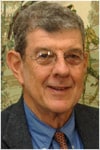Biographies - Ebola

In 1976, while an EIS officer in Michigan, Dr. Breman was called to investigate an unusually lethal outbreak in the Equateur Province of Democratic Republic of Congo (then called Zaire). Working with scientists and public health teams from 6 countries and WHO, he became Chief of Control, Surveillance, and Epidemiology for the International Commission to Investigate and Control Ebola Hemorrhagic Fever in Zaire.
Dr. Breman worked on smallpox eradication, measles control, and disease surveillance as a CDC assignee to Guinea, Burkina Faso (Upper Volta), and WHO, Geneva. Following the eradication of smallpox, Breman returned to CDC where he worked on malaria treatment, epidemiology and control in Africa. In 1995, he followed his wife, an environmental lawyer, to Washington, DC, to become Director, Program in Emerging Infectious Diseases, Fogarty International Center, NIH.
Dr. Breman was educated at the University of California, Los Angeles; Keck School of Medicine, University of Southern California (USC); and the London School of Hygiene and Tropical Medicine. He trained in internal medicine at the USC-Los Angeles County Medical Center, infectious diseases at the Channing Laboratory, Harvard Medical School, and epidemiology at CDC. He is Senior Scientist Emeritus, NIH and President-Elect, the American Society of Tropical Medicine and Hygiene.

James Lange received his B.S. and M.S. in microbiology from LSU Baton Rouge and a PhD in Pathology from UNC Chapel Hill. His CDC career started with diagnostic virology and epidemiologic work in CDC’s MCL (Maximum Containment Laboratory). In 1976, he isolated and characterized a virus isolate Karl Johnson named Ebola virus. In 1988, he moved to NIAID in Bethesda, serving as resident scientist for USAID’s Middle East Regional Cooperation project, facilitating collaborative research between Egyptian and Israeli scientists, culminating in a dozen Egyptians training at the Kuvin Centre, Hadassah Medical School.
Returning to CDC in 1991 he joined the Public Health Practice Program Office. He developed projects to evaluate clinical diagnostic testing for viral infectious diseases and training programs for CDC’s contribution to the Defense Department’s Defense Threat Reduction Agency’s effort against biothreat agents in Former Soviet Union Countries. His last move to the Division of Preparedness and Emerging Infections presented new opportunities to deploy to domestic and international public health emergencies. His deployments included Hurricane Katrina, Liberia, Sierra Leone, Puerto Rico and Miami. He also served as a U.S. Army Reservist, with deployments to Vietnam as a rifle platoon leader (1970–71) and Iraq as Theater Laboratory Consultant (2006–07). He retired from the Army in 2009 and from CDC in 2017. He and his wife of 50 years, Neilanne Parker Lange, reside in New Orleans.

Since 2009, Dr. Towner has led the Virus Host Ecology Team within Viral Special Pathogens Branch (VSPB) to study replication, transmission and spillover of hemorrhagic fever viruses (VHFs), including the bat-borne filoviruses, Ebola and Marburg viruses, and the newly identified paramyxovirus, Sosuga virus. His team has worked with multiple universities and government agencies throughout Africa, Asia and the United States and currently supports and supervises disease ecology programs in Uganda and Sierra Leone.
Dr. Towner completed his B.A at the University of California, Berkeley, and his PhD at the University of California, Irvine. He came to VSPB in 1997 to develop reverse genetic systems to study virulence determinants of Ebola virus. However, after deploying to the Ebola virus disease (EVD) outbreak in Gulu, Uganda in 2000 to establish PCR-based diagnostics, his focus shifted to the development of high-throughput diagnostic platforms for VHFs. Dr. Towner has deployed to Angola, Uganda, Kenya, Gabon and Sierra Leone to establish these platforms for outbreak diagnostics or to conduct ecological investigations to identify reservoir hosts of VHFs. Through outbreak investigations and experimental infection studies, his team helped identify the Egyptian rousette bat (Rousettus aegyptiacus) as the natural reservoir for Marburg, Ravn and Sosuga viruses. His team was also instrumental in the discovery of Bundibugyo virus, the newest member of the genus Ebolavirus known to cause disease in humans, and the causative agent of EVD outbreaks in Uganda in 2007 and DRC in 2012. Dr. Towner has 28 years of training as a molecular virologist and 22 years of experience conducting research under BSL-4 containment.